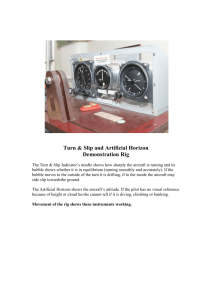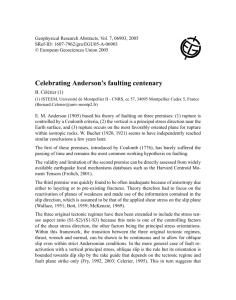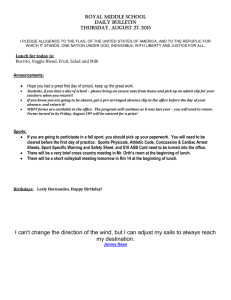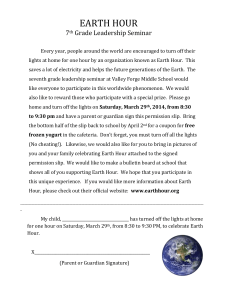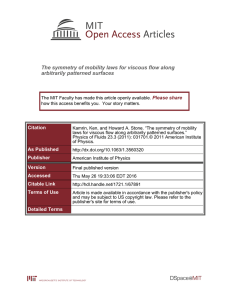PPT file
advertisement
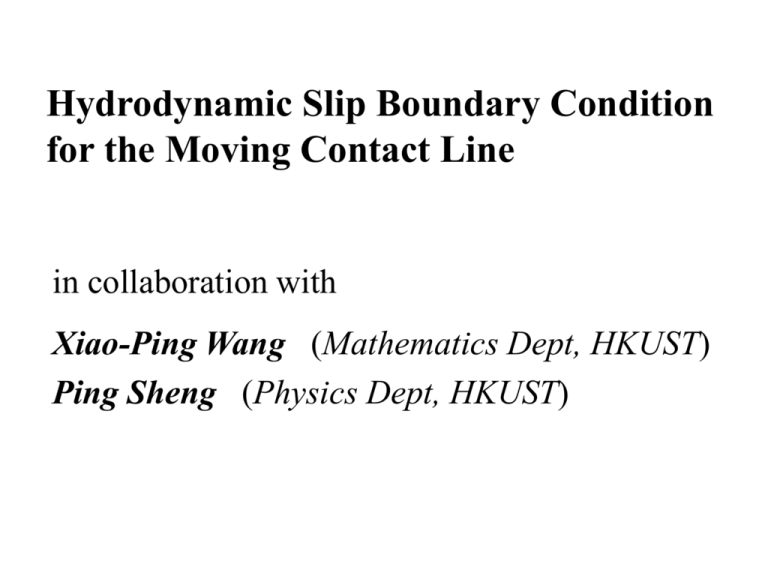
Hydrodynamic Slip Boundary Condition for the Moving Contact Line in collaboration with Xiao-Ping Wang (Mathematics Dept, HKUST) Ping Sheng (Physics Dept, HKUST) v slip 0 ? No-Slip Boundary Condition v slip 0 from Navier Boundary Condition to No-Slip Boundary Condition v slip ls : shear rate at solid surface ls : slip length, from nano- to micrometer Practically, no slip in macroscopic flows slip s v /U l / R 0 cos s 2 1 No-Slip Boundary Condition ? Apparent Violation seen from the moving/slipping contact line Infinite Energy Dissipation (unphysical singularity) Are you able to drink coffee? Previous Ad-hoc models: No-slip B.C. breaks down • Nature of the true B.C. ? (microscopic slipping mechanism) • If slip occurs within a length scale S in the vicinity of the contact line, then what is the magnitude of S ? Molecular Dynamics Simulations • initial state: positions and velocities • interaction potentials: accelerations • time integration: microscopic trajectories • equilibration (if necessary) • measurement: to extract various continuum, hydrodynamic properties • CONTINUUM DEDUCTION Molecular dynamics simulations for two-phase Couette flow • • • • • • • Fluid-fluid molecular interactions Wall-fluid molecular interactions Densities (liquid) Solid wall structure (fcc) Temperature System size Speed of the moving walls Modified Lennard-Jones Potentials U ff 4 [( / r ) ff ( / r ) ] 12 6 U wf 4 wf [( wf / r ) wf ( wf / r ) ] 12 6 ff 1 for like molecules ff 1 for molecules of different species wf for wetting property of the fluid fluid-1 fluid-2 fluid-1 dynamic configuration f-1 f-2 f-1 symmetric f-1 f-2 asymmetric static configurations f-1 boundary layer tangential momentum transport The Generalized Navier B. C. ~f slip Gx vx ~f ~ Gx zx (0) when the BL thickness shrinks down to 0 Y ~ ~ zx (0) [ z vx ](0) zx (0) viscous part non-viscous part Origin? uncompensated Young stress Y Y 0 ~ (0) (0) (0) zx zx nonviscous part zx s ,d dx int 0 ,Y zx viscous part Uncompensated Young Stress missed in Navier B. C. • Net force due to hydrodynamic deviation from static force balance (Young’s equation) • NBC NOT capable of describing the motion of contact line • Away from the CL, the GNBC implies NBC for single phase flows. Continuum Hydrodynamic Modeling Components: • Cahn-Hilliard free energy functional retains the integrity of the interface (Ginzburg-Landau type) • Convection-diffusion equation (conserved order parameter) • Navier - Stokes equation (momentum transport) • Generalized Navier Boudary Condition Diffuse Fluid-Fluid Interface Cahn-Hilliard free energy (1958) FCH 1 2 dr [ K ( ) f ( )] 2 ( 2 1 ) /( 2 1 ) 1 2 1 4 f ( ) r u 2 4 2 / t v M m [v / t (v )v ] p m g ext v FCH / capillary force density is the chemical potential. v slip x ~ zx (0) [ z vx ](0) [( K z wf / ) x ](0) = tangential viscous stress + uncompensated Young stress Young’s equation recovered in the static case by integration along x [ / t v ](0) [ K z wf ( ) / ](0) for boundary relaxation dynamics first-order generalization from K z wf ( ) / 0 in equilibrium, together with / t v 0 Comparison of MD and Continuum Hydrodynamics Results • Most parameters determined from MD directly • M and optimized in fitting the MD results for one configuration • All subsequent comparisons are without adjustable parameters. molecular positions projected onto the xz plane near-total slip at moving CL no slip vx / V 1 Symmetric Coutte V=0.25 H=13.6 v x (x) profiles at different z levels symmetric Coutte V=0.25 H=13.6 asymmetric Coutte V=0.20 H=13.6 symmetric Coutte V=0.25 H=10.2 symmetric Coutte V=0.275 H=13.6 asymmetric Poiseuille gext=0.05 H=13.6 The boundary conditions and the parameter values are both local properties, applicable to flows with different macroscopic/external conditions (wall speed, system size, flow type). Summary: • A need of the correct B.C. for moving CL. • MD simulations for the deduction of BC. • Local, continuum hydrodynamics formulated from Cahn-Hilliard free energy, GNBC, plus general considerations. • “Material constants” determined (measured) from MD. • Comparisons between MD and continuum results show the validity of GNBC. Large-Scale Simulations • MD simulations are limited by size and velocity. • Continuum hydrodynamic calculations can be performed with adaptive mesh (multi-scale computation by Xiao-Ping Wang). • Moving contact-line hydrodynamics is multiscale (interfacial thickness, slip length, and external confinement length scale).



